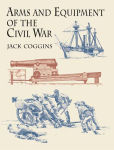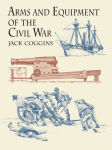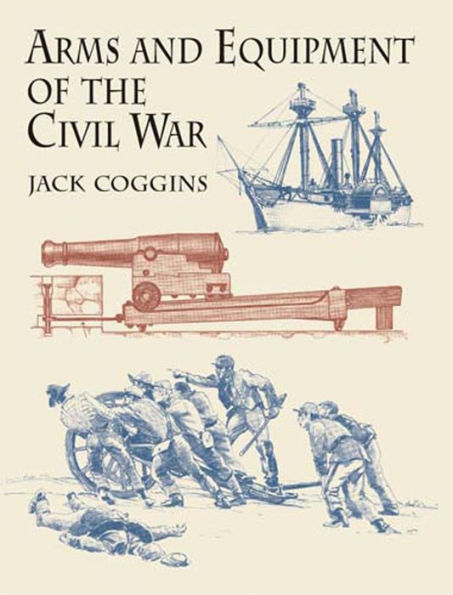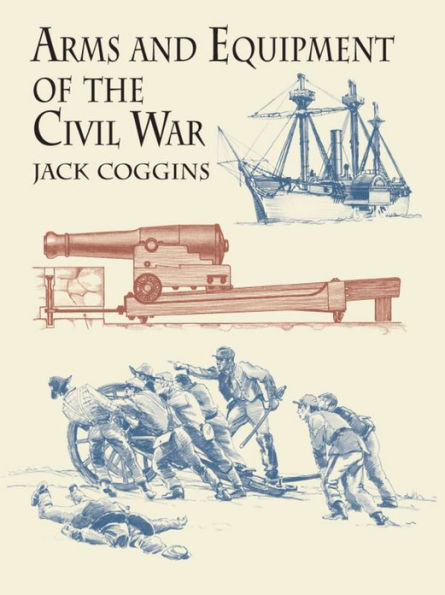Profusely illustrated with hundreds of the author's own drawings, Jack Coggins's remarkable encyclopedia of military hardware and technology also describes such equipment as pontoon bridges, corduroy roads, "excelsior" percussion grenades, "freak guns," siege artillery, mines, and submarine torpedoes. Offering a new view on how military resources decided the outcome not only of battles, but of the war as well, the text also includes on-the-scene comments by Union and Confederate soldiers about equipment and camp life in general.
A must-have book for every Civil War enthusiast and for readers interested in the development of weaponry.
Profusely illustrated with hundreds of the author's own drawings, Jack Coggins's remarkable encyclopedia of military hardware and technology also describes such equipment as pontoon bridges, corduroy roads, "excelsior" percussion grenades, "freak guns," siege artillery, mines, and submarine torpedoes. Offering a new view on how military resources decided the outcome not only of battles, but of the war as well, the text also includes on-the-scene comments by Union and Confederate soldiers about equipment and camp life in general.
A must-have book for every Civil War enthusiast and for readers interested in the development of weaponry.


eBook
Available on Compatible NOOK devices, the free NOOK App and in My Digital Library.
Related collections and offers
Overview
Profusely illustrated with hundreds of the author's own drawings, Jack Coggins's remarkable encyclopedia of military hardware and technology also describes such equipment as pontoon bridges, corduroy roads, "excelsior" percussion grenades, "freak guns," siege artillery, mines, and submarine torpedoes. Offering a new view on how military resources decided the outcome not only of battles, but of the war as well, the text also includes on-the-scene comments by Union and Confederate soldiers about equipment and camp life in general.
A must-have book for every Civil War enthusiast and for readers interested in the development of weaponry.

Product Details
| ISBN-13: | 9780486131276 |
|---|---|
| Publisher: | Dover Publications |
| Publication date: | 02/08/2012 |
| Series: | Civil War |
| Sold by: | Barnes & Noble |
| Format: | eBook |
| Pages: | 160 |
| File size: | 18 MB |
| Note: | This product may take a few minutes to download. |
About the Author
Read an Excerpt
ARMS AND EQUIPMENT OF THE CIVIL WAR
By JACK COGGINS
Dover Publications, Inc.
Copyright © 1990 Jack CogginsAll rights reserved.
ISBN: 978-0-486-13127-6
CHAPTER 1
THE ARMY
THE evaluation of the fighting abilities of the Civil War soldier is beyond the scope of this book. The war was fought mainly between men of Anglo-Saxon stock, often between men of the same family. Their basic weapons were in a majority of cases the same. Both sides faced the same problems of discipline inherent in armies of volunteers hastily raised in a country of rugged individualists whose nationals placed freedom of speech and action above all else. Desertions and "absenteeism" plagued each side. Both sides had their moments of triumph and of defeat, of heroism and of panic.
If, as is sometimes claimed, the morale of the Southern soldier was higher, it might have been that he was, in nearly every instance, defending his home territory against an invader. Accustomed to victory, and fortunate in possession of a beloved and war-wise leader, the Confederate soldier, ill-fed and poorly equipped as he often was, performed feats seldom if ever equaled in the history of warfare. Yet few could match the stubborn valor of the men of the Army of the Potomac—often defeated, almost always outgeneraled, and sometimes outfought, but always coming back, under some new commander, to try conclusions again with the "invincible Southerners."
Often studiedly casual in attire, informal in dealings with his superiors, and lax in matters of discipline, the men whom Moltke referred to as an armed rabble could yet, on occasion, dress ranks under fire and advance again and again over ground swept by the deadliest musketry yet seen in warfare. If somewhat lacking in spit and polish; in ingenuity and inventiveness, they were the superior of any troops on earth. Certainly they were a breed of soldier the like of which the world had never seen, and will never see again.
In organization the opposing armies were much the same. This is natural enough, as the senior officers of both sides were West Pointers, often from the same regiments in the regular army. The regiment was the basic unit of infantry and cavalry, and the battery, of the artillery. Regiments were grouped into brigades, brigades into divisions, divisions into corps, and corps into armies.
The regiment, infantry or cavalry, theoretically numbered about one thousand men. It seldom mustered one half of that, and was constantly increasing or decreasing, usually the latter, as losses through battle or disease were seldom equaled by drafts of new recruits.
Confederate regiments tended to be a little stronger than Union regiments. Until late in the war the average strength of Union Army corps or divisions was about half that of the Confederates. This should be borne in mind, as it can lead to considerable confusion. For instance, the four Confederate divisions which bore the brunt of the first days fighting at Gettysburg, those of Early, Heth, Pender, and Rodes, totaled some 25,000 men. The six divisions of the I and XI corps of the Union army which opposed them totaled a little under 20,000 (the figures are General Longstreet's).
A strong Confederate infantry brigade might contain almost as many men as a weak Federal division, but the fighting effectiveness would not be the same, as the Federal formation, being a division, might include all arms, while the Confederates would be all infantry.
In 1864 the Army of the Potomac was reorganized, and the five corps consolidated into three, at which time each corps averaged some 26,000 men.
Union commanders seldom held as high rank as their opponents. Thus Union Army corps were commonly commanded by major generals, while a Confederate corps would be under a lieutenant general. Lee was a full general, while McClellan, Hooker, Meade, and other commanders of the Army of the Potomac were only major generals, and Grant was only made a lieutenant general in March 1864. Confederate divisional commanders were major generals, while Federal divisions were usually headed by brigadiers. A brigade, while theoretically commanded by a brigadier general, was more often commanded in the Union Army by a colonel.
At Gettysburg, the Army of the Potomac was made up of seven army corps, with fifty-one infantry brigades, grouped in nineteen divisions, sixteen of which were commanded by brigadiers. Twenty-two of the brigades were commanded by brigadier generals and twenty-nine by colonels. The Army of Northern Virginia consisted of three army corps, divided into nine divisions, with thirty-seven brigades. Of these brigades, only three were commanded by colonels.
While much mention is often made of the sizes of various commands, it is actually almost impossible to assess numerical strengths of units in either army at any one time. Numbers given were often for strengths listed on the rolls. Actual strengths of bayonets carried into battle were much smaller. Some of the loss can be attributed to sickness, but by far the greater proportion must be set down to straggling. Stragglers, skulkers, absentees, and deserters were the curse of both armies throughout the war.
Meade declared that over 8000 men, including 250 officers, had quit the ranks of Hooker's corps before or during the Battle of Antietam. Jackson's division lost 700 out of 1600 effectives at the same battle, yet less than two weeks later, as the laggards drifted in, mustered 3900. Rapid marching accounted for some of the straggling, but the tendency of both Union and Confederate troops to stray whenever they felt like it was the main reason.
Accustomed as we are to the rules, regulations, and red tape of soldiering in the twentieth century, it seems incredible that thousands of men of both armies should wander off, many to rejoin the colors later, other to keep going "over the hill."
"The state of the North are flooded with deserters and absentees" wrote McClellan, and Lee complained that "the absent are scattered broadcast over the land."
It is safe to estimate that, given twenty thousand infantry to start with, a general would be lucky if, after two or three weeks of maneuvering, he would be able to put sixteen thousand into the line of battle.
Of the Southerners, Henderson wrote:
"Many, without going through the formality of asking leave, would make for their homes, and had no idea that their conduct was in any way peculiar. They had done their duty ... the enemy had been driven from Virginia, and they considered that they were fully entitled to some short repose. "
Neither orders, appeals, or arrests and punishments seemed to have any effect; nor could cavalry patrols or provost marshal's guards check the constant drifting away. True, a lot of these absentees "drifted" back, but, as many a despairing regular must have exclaimed, "This is a helluva way to run an army."
For while in bravery, hardihood, and self-reliance the Civil War soldier was second to none, yet time and again, through lack of discipline, a battle was lost and the results of a hard-won fight thrown away. Both sides prided themselves in relying more on wits and natural intelligence than on blind obedience. Yet such discipline need not imply a mere machine-soldier, an automaton with every ounce of initiative whipped or drilled out of him. There is a happy medium, the product of careful and intelligent training in which initiative and the habits of unhesitating obedience are combined. Unfortunately such schooling takes time, and a superior and well-trained type of officer. Neither North nor South had either time or such officers; and so Johnny Reb and Billy Yank went their own sweet ways, fighting like demons and straying like school boys; in the ranks today and off to help with the plowing tomorrow.
THE cavalry regiments at Gettysburg were grouped in brigades of which the Confederates had seven and the Union forces, eight. The Army of the Potomac by this time had organized its cavalry brigades into divisions and the divisions into a cavalry corps. The Confederates under Stuart were in a division and two separate brigades.
The Southern guns were mostly in battalions —each battalion consisting of four four-gun batteries. Each corps had five battalions assigned to it—a battalion to each division plus two in the reserve. A Union corps had an artillery brigade (four or five batteries) attached, and an army reserve of some twenty-four batteries.
Each general officer had his own staff of assistants, a group of specialists in which were represented all the services, and who bore much the same relationship to their commanding officer as the heads of departments do to the president of a large company. The staff was usually divided. The military staff included the chief of artillery, chief or inspector of cavalry, the chief engineer, the provost marshal general, and the chief signal officer, while the administrative staff included the chief ordnance officer, chief quartermaster, commissary, chief paymaster, and medical director. A chief of staff headed all these, and took much of the administrative load off the commanding officer, writing orders and seeing that they were carried out, thus relieving his general of all petty details and annoyances and leaving him free to concentrate on strategic and tactical problems.
Aides-de-camp were attached to the general's personal staff, usually in a non-technical capacity. They were in a sense glorified messengers, but also acted to a certain extent as their commander's eyes as well as his mouth. For this reason, they had to be capable of giving a concise and accurate description of the situation in the parts of the field to which they were sent. They might also, as staff members (and as such presumably knowing their general's intentions) give orders in emergencies where there was no time to consult the commanding officer himself.
All staffs were (or should have been) kept as small as possible, and occasionally heads of services were omitted, or did double duty: for instance, a chief of artillery might take over the duty of ordnance officer. In smaller organizations, such as divisional staffs, aides might perform the duties of ordnance officers, engineer officers, etc.
The staff organizations were repeated on a smaller scale down through divisions and brigades. There were also military secretaries, clerks, messengers, etc.
Armies in the Civil War were usually referred to by locality, such as the Army of the Potomac, the Army of the Ohio, and the Army of the Cumberland of the Union forces, and the Army of Northern Virginia, the Army of Tennessee, the Army of the West of the Confederacy.
Corps were usually organized into three divisions. Corps were numbered and the Union Army had corps insignia in the shape of badges worn on cap or hat.
Divisions were normally of three brigades each. The Union corps insignia was worn as a divisional badge, red for the first division, white for the second, blue for the third, and, if more than three, green for the fourth and orange for the fifth division. The Confederates wore no division or corps insignia.
THE following are quotes from men of both armies concerning equipment and camp life.
"The knapsack ... is an unwieldly burden with its.... contents of flannel and sole leather and sometimes twenty rounds of ammunition extra. Mixed in ... are photographs, cards, huswife, testament, pens, ink, paper, and oftentimes stolen truck enough to load a mule. All this is crowned with a double wool blanket and half a shelter tent rolled in a rubber blanket. One shoulder and the hips support the 'commissary department.' —an odorous haversack, which often stinks with its mixture of bacon, pork, salt junk, sugar, coffee, tea, desicated vegetables, rice, bits of yesterday's dinner, and old scraps...."
The early Confederate knapsack contained a similar load. "On the outside ... were two great blankets and a rubber or oil cloth. This knapsack, etc., weighed from fifteen to twenty-five pounds, sometimes more." But "The knapsack vanished early in the struggle. It was inconvenient to change the underwear too often.... The better way was to dress out and out, and wear that outfit until the enemy's knapsacks, or the folks at home supplied a change."
"Reduced to the minimum, the private soldier consisted of one man, one hat, one jacket, one shirt, one pair of pants, one pair of drawers, one pair of shoes and one pair of socks. His baggage was one blanket, one rubber blanket, and one haversack."
"One blanket to each man was found to be as much as could be carried, and amply sufficient for the severest weather."
"Experience soon demonstrated that boots were not agreeable on a long march ... good, strong brogues or brogans, with broad bottoms and big flat heels, succeeded the boots...."
"Shoes are very scarce. The men get pieces of raw hide from the butchers, and, after wrapping their feet up in old rags, sew the hide around them ... which they wear until it wears out."
"Caps .... finally yielded to the demands of comfort and common sense, and a good soft felt hat worn instead."
"Overcoats, an inexperienced man would think an absolute necessity for men exposed to the rigors of a northern Virginia winter. But ... they were found to be a great inconvenience.... Some carried them to the last but the majority got tired of lugging them around."
"Canteens were ... as a general thing discarded.... A good strong tin cup was found better than a canteen, as it was easier to fill at a well or spring, and was serviceable as a boiler for making coffee."
"In addition ... each mess, generally composed of from five to ten men, ... had its outfit, consisting of a large camp chest containing skillet, frying pan, coffee boiler, bucket for lard, coffee box, salt box, meal box, flour box, knives, forks, spoons, plates, cups, etc.... so large that eight or ten of them filled up an army wagon...."
"The camp-chest soon vanished. The brigadiers and major-generals, even, found them too troublesome.... One skillet and a couple of frying pans, a bag of flour or meal, another bag of salt, sugar and coffee, ... served the purpose as well."
"General Lee has just issued (July 1863) a very wise order cutting down the regimental transportation to one wagon for every 300 men...."
"The cavalrymen found sabres very tiresome when swung to the belt and adopted the plan of fastening them to the saddle on the left side, with the hilt in front and in reach of the right hand." (In later years, standard practice among cavalrymen everywhere.)
"I lay down with my feet to the fire, my saddle as a pillow, the oil cloth under me and a blanket over me.... The fire was made some fifteen feet long.... In this way three or four fires could accommodate my whole company, both officers and men."
"I have no bed and water runs through my tent, as the ditch only gathers it so it can creep through my floor of dark mould, which is literally spongy with moisture, and my poor oil-cloth does not keep the dampness off me."
The natural instincts of a recruit is to surround himself with all the comforts of home, including a canvas replica of home itself. The transportation problem alone proved insoluable and the larger tents with which most units encumbered themselves in 1861 speedily gave place to the little "pup" tent. These were not well received at first. They were called kennels and dog-holes and adorned with signs reading "Pups for sale," "Sons of bitches within," "Rat-terriers," and other examples of camp humor. But handiness and ease of transportation (each man carried half a tent) outweighed lack of roominess.
The Sibley—which was large enough for a stove, so large in fact, that it was not generally used in the field, but in more permanent camps, could (and usually did) sleep double its regulation number. A score or more could sleep on their sides, spoon fashion, feet to the stove in the center. At the cry "Spoon" all would roll over and settle down on the other side.
Wall tents of various sizes and patterns were used. Again, a rarity among the lower ranks in the field, although headquarters might afford the luxury of transporting a few.
But if the veteran prided himself on his ability to make do with the most meager shelter, or none at all, when campaigning, his ingenuity knew no bounds when making himself comfortable in permanent camps and winter quarters. Log or sod cabins, wood and canvas contraptions, dugouts and combinations of all these were built, drainage was carefully planned (at least by the more experienced), and much thought and labor put into chimneys and fireplaces.
Bands were great morale-builders. Lee once said, "I don't believe we can have an army without music." An ex-drummer boy reminisced, "When a dozen or more of the lads, ... led the regiment in a review with their get-out-of-the-way-old-DanTuckerish style of music, it made the men in the ranks step off as though they were bound for a Donnybrook Fair."
Bands played under fire, as well as in camp and on the march. As the war progressed some regiments replaced the bands with fife and drum corps. On the other hand, General Porter reports coming across one of Sheridan's mounted bands under heavy fire at Five Forks in March of '65, "Playing 'Nelly Bly' as cheerfully as if it were furnishing music for a country picnic."
The soldier's day started with the sound of bugle and drum.
"From some commanding elevation the clear-toned bugle sounds out the reveille and another responds, ... intermingled with this comes the beating of drums, often rattling and jarring on unwilling ears."
(Continues...)
Excerpted from ARMS AND EQUIPMENT OF THE CIVIL WAR by JACK COGGINS. Copyright © 1990 Jack Coggins. Excerpted by permission of Dover Publications, Inc..
All rights reserved. No part of this excerpt may be reproduced or reprinted without permission in writing from the publisher.
Excerpts are provided by Dial-A-Book Inc. solely for the personal use of visitors to this web site.
Table of Contents
Contents
Title Page,Dedication,
Copyright Page,
AUTHOR'S PREFACE,
THE ARMY,
THE INFANTRY,
THE CAVALRY,
THE ARTILLERY,
THE ENGINEERS,
THE SIGNAL CORPS,
RAILROADS,
THE MEDICAL DEPARTMENTS,
THE QUARTERMASTER CORPS,
THE NAVIES,
BIBLIOGRAPHY,
INDEX,



